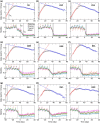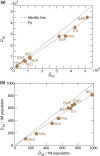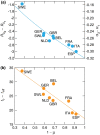Effects of social distancing on the spreading of COVID-19 inferred from mobile phone data
- PMID: 33462369
- PMCID: PMC7813880
- DOI: 10.1038/s41598-021-81308-2
Effects of social distancing on the spreading of COVID-19 inferred from mobile phone data
Abstract
A better understanding of how the COVID-19 pandemic responds to social distancing efforts is required for the control of future outbreaks and to calibrate partial lock-downs. We present quantitative relationships between key parameters characterizing the COVID-19 epidemiology and social distancing efforts of nine selected European countries. Epidemiological parameters were extracted from the number of daily deaths data, while mitigation efforts are estimated from mobile phone tracking data. The decrease of the basic reproductive number ([Formula: see text]) as well as the duration of the initial exponential expansion phase of the epidemic strongly correlates with the magnitude of mobility reduction. Utilizing these relationships we decipher the relative impact of the timing and the extent of social distancing on the total death burden of the pandemic.
Conflict of interest statement
The authors declare no competing interests.
Figures





References
-
- Jacqui W. Covid-19: surveys indicate low infection level in community. BMJ. 2020;369:m1992. - PubMed
Publication types
MeSH terms
LinkOut - more resources
Full Text Sources
Other Literature Sources
Medical

